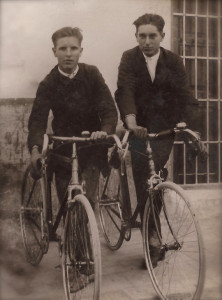
Two things that jump out from a cursory glance at The Continong by the pseudonymous Anar de la Grenouillere, F.O.N.S., of which a file copy of the fourth edition of 1906 was found at Jot HQ the other day, is first the rather forced facetious tone of its advice to travellers to France, and secondly the predominance of references to cyclists.
In 1894, when The Continong first appeared, the motor car had only been around for a handful of years and so presumably the author did not feel it necessary even to acknowledge its existence. But by 1906, when many more manufacturers were producing cars, this rise in traffic is not acknowledged in this ‘revised and updated ‘edition. Touring France for the English speaker was still all about railways or, in Paris, ‘buses and trams ( though not the Metro, although this had been established by 1906) possibly walking, horse-drawn ‘cabs’ but most of all, cycling. Compared to the four pages devoted to railways and three on cabs and cabbies, the author provides fifteen pages of advice for cyclists.
The first few pages of this advice are devoted to what to expect on arriving in France. British cyclists are urged to join the TFC (Touring Club de France) which was founded in 1890. For a mere five shillings a year, benefits include a Handbook, and the exemption of duty on their cycles, and for a few extra francs a Year-book containing a list of over 3,000 approved hotels, at which members enjoy a privileged position as to charges, a Year-book for foreign countries and a book of ‘skeleton tours’ for the whole of France and adjoining countries. Incidentally, a compulsory requirement for cycles being ridden in France and elsewhere on the continent was a name-plate ‘bearing the name and address of the owner (and) attached to the machine’. This seems to have been the equivalent of a car licence plate, which back then became a legal required for motor vehicles in 1903. Again, this suggests that cycles were seen as the predominant form of personal transport, at least in France.
Continue reading
 Found among a pile of newspaper clippings at Jot HQ is this substantial analysis in the 2 December 1935 issue of the Financial Timesof the thriving bicycle industry.
Found among a pile of newspaper clippings at Jot HQ is this substantial analysis in the 2 December 1935 issue of the Financial Timesof the thriving bicycle industry.
